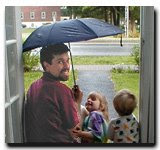June's Sustainable Living Tip from F.W. Horch:
Save money and reduce waste with rechargeable batteries.
Save money and reduce waste with rechargeable batteries.
Battery Facts
- One rechargeable battery can replace up to 1,000 disposable batteries.
- According to the EPA, Americans purchase 3,000,000,000 (three billion) batteries every year.
- For pollution-free recharging, choose "green electricity" (made in Maine from hydropower and wind facilities). Or choose a battery charger with a built-in solar panels or adapters for plugging in to a solar panel.
- Small disposable alkaline batteries (sizes AAA, AA, C and D) start at above 1.5 volts and drop unevenly to 1.0 volts during discharge, whereas nickel metal hydride (NiMH) rechargeable batteries stay at a relatively constant 1.2 volts for most of their discharge cycle.
- A nine volt battery is six smaller 1.5 volt batteries wired in series.
- Older types of NiMH rechargeable batteries would self-discharge at about 1% per day, requiring frequent recharges. Newer NiMH batteries lose only about 0.07% of their charge per day, making them much more practical for many uses.
- NiMH rechargeable batteries are qualified as non-hazardous.
- Lithium ion rechargeable batteries (typically used in laptops and cell phones) are also qualified as non-hazardous.
- The older nickel cadmium (NiCad) rechargeable batteries are hazardous and must be disposed of as household hazardous waste. Avoid this type of battery if possible.
- Lead acid rechargeable batteries (typically used in cars and uninterruptible power supplies) are hazardous and should be recycled.
- Disposable alkaline batteries manufactured before 1996 could contain mercury and should be considered potentially hazardous.


No comments:
Post a Comment